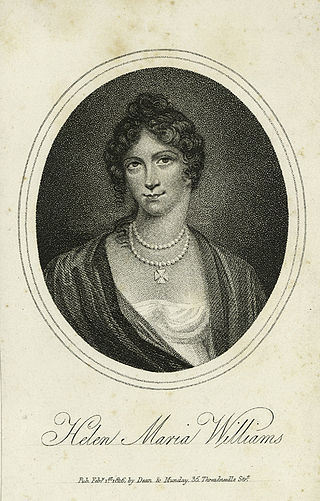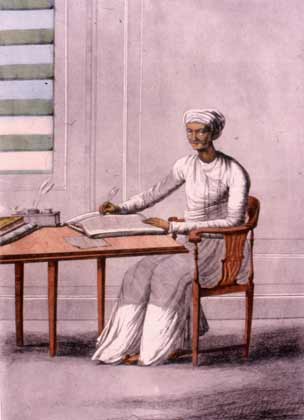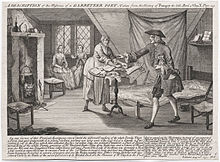Relationship to other genres
With works of Mary Ann Kilner of the 1780s, Adventures of a Pincushion and Memoirs of a Peg-Top, it-novels became part of children's literature. [21] One offshoot was a style of satirical children's verse made popular by Catherine Ann Dorset, based on a poem by William Roscoe, The Butterfly's Ball and The Grasshopper's Feast . [22] Quite generally, it-narrative in the 19th century is typified by an animal narrator. [23]
It has been remarked that the slave narrative genre of the 18th century avoided being confused with the it-narrative, being thought of as a type of biography. [24]
The plot of Middlemarch has been seen to be structured, initially, by a circulation; but to end in a contrasting "subject narrative". [25]
Alberto Toscano and Jeff Kinkle have argued that one popular form of hyperlink cinema, a genre of film characterized by intersecting and multilinear plots, constitutes a contemporary form of it-narrative. [26] In these films, they argue, "the narrative link is the characters' relation to the film's product of choice, whether it be guns, cocaine, oil, or Nile perch." [26]

Children's literature or juvenile literature includes stories, books, magazines, and poems that are created for children. Modern children's literature is classified in two different ways: genre or the intended age of the reader.

An antiquarian or antiquary is an aficionado or student of antiquities or things of the past. More specifically, the term is used for those who study history with particular attention to ancient artifacts, archaeological and historic sites, or historic archives and manuscripts. The essence of antiquarianism is a focus on the empirical evidence of the past, and is perhaps best encapsulated in the motto adopted by the 18th-century antiquary Sir Richard Colt Hoare, "We speak from facts, not theory."
In psychology and psychiatry, scopophilia or scoptophilia is an aesthetic pleasure drawn from looking at an object or a person. In human sexuality, the term scoptophilia describes the sexual pleasure that a person derives from looking at prurient objects of eroticism, such as pornography, the nude body, and fetishes, as a substitute for actual participation in a sexual relationship.
Charles Gildon, was an English hack writer who was, by turns, a translator, biographer, essayist, playwright, poet, author of fictional letters, fabulist, short story author, and critic. He provided the source for many lives of Restoration figures, although he appears to have propagated or invented numerous errors with them. He is remembered best as a target of Alexander Pope's in both Dunciad and the Epistle to Dr. Arbuthnot and an enemy of Jonathan Swift's. Gildon's biographies are, in many cases, the only biographies available, but they have nearly without exception been shown to have wholesale invention in them. Because of Pope's caricature of Gildon, but also because of the sheer volume and rapidity of his writings, Gildon has come to stand as the epitome of the hired pen and the literary opportunist.

Helen Maria Williams was a British novelist, poet, and translator of French-language works. A religious dissenter, she was a supporter of abolitionism and of the ideals of the French Revolution; she was imprisoned in Paris during the Reign of Terror, but nonetheless spent much of the rest of her life in France. A controversial figure in her own time, the young Williams was favourably portrayed in a 1787 poem by William Wordsworth.
In literature, psychological fiction is a narrative genre that emphasizes interior characterization and motivation to explore the spiritual, emotional, and mental lives of the characters. The mode of narration examines the reasons for the behaviors of the character, which propel the plot and explain the story. Psychological realism is achieved with deep explorations and explanations of the mental states of the character's inner person, usually through narrative modes such as stream of consciousness and flashbacks.
Marie-Jeanne Riccoboni, whose maiden name was Laboras de Mézières, was a French actress and novelist.

Tartanry is the stereotypical or kitsch representation of traditional Scottish culture, particularly by the emergent Scottish tourist industry in the 18th and 19th centuries, and later by the American film industry. The earliest use of the word "tartanry" itself is said to have been in 1976. The phenomenon was explored in Scotch Myths, a culturally influential exhibition devised by Barbara and Murray Grigor and Peter Rush and mounted at the Crawford Centre at the University of St. Andrews in the Spring of 1981.
Lee Upton is an American poet, fiction writer, literary critic, and a graduate of the MFA Program for Poets & Writers at the University of Massachusetts Amherst.
Alexander von Reisden is a fictional character in a three book historical mystery series by Sarah Smith. The novels, set in turn of the 20th century Boston and pre-World War I Paris, are The Vanished Child (1992), The Knowledge of Water (1996), and A Citizen of the Country (2000).
Sarah Smith is an American author living in Brookline, Massachusetts.
Penelope Aubin was an English novelist, poet, and translator. She published seven novels between 1721 and 1728. Aubin published poetry in 1707 and turned to novels in 1721; she translated French works in the 1720s, spoke publicly on moral and political issues at her Lady's Oratory in 1729, and wrote a play in 1730. Aubin died in April 1738, survived by her husband until his death in April 1740. After the author's death, her works were gathered and published as A Collection of Entertaining Histories and Novels, Designed to Promote the Cause of Virtue and Honor. Aubin's works have a long history after her death, being both plagiarised and published transatlantically. She is one of a number of eighteenth-century women writers whose works and biography is being more rigorously explored by modern scholars.
Sophistication has come to mean a few things, but its original uses were a pejorative, derived from sophist, and included the idea of admixture or adulteration. Today, as researched by Faye Hammill, it is common as a measure of refinement—displaying good taste, wisdom and subtlety rather than crudeness, stupidity and vulgarity. In the perception of social class, sophistication can be linked with concepts such as status, privilege and superiority.

Kulin Kayasthas are a sub-caste of the Kayastha caste in West Bengal, India. They are also known as the Kulina Kayasthas.
Edward Kimber (1719–1769) was an English novelist, journalist and compiler of reference works.
Helenus Scott M.D. (1760–1821) was a Scottish physician.
Robina Forrester Hardy, known professionally as Robina F. Hardy, was a Scottish Victorian author, poet and Christian missionary.
Susan Smythies was a British story writer from Colchester in Essex.

The type of romance considered here is mainly the genre of novel defined by the novelist Walter Scott as "a fictitious narrative in prose or verse; the interest of which turns upon marvellous and uncommon incidents", in contrast to mainstream novels which realistically depict the state of a society. These works frequently, but not exclusively, take the form of the historical novel. Scott's novels are also frequently described as historical romances, and Northrop Frye suggested "the general principle that most 'historical novels' are romances". Scott describes romance as a "kindred term", and many European languages do not distinguish between romance and novel: "a novel is le roman, der Roman, il romanzo".






